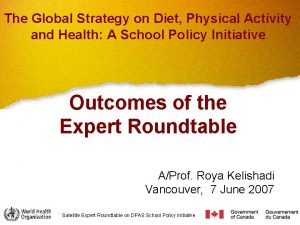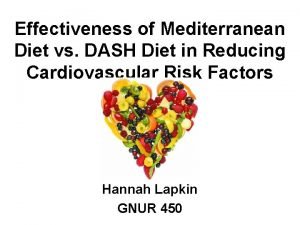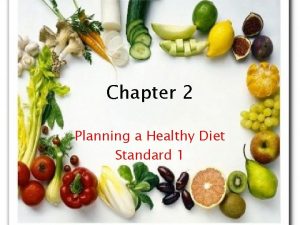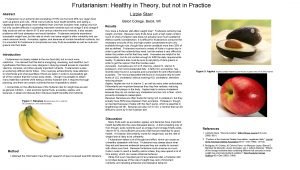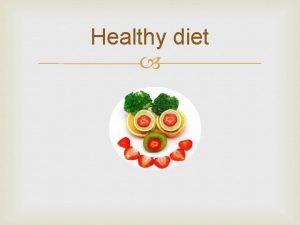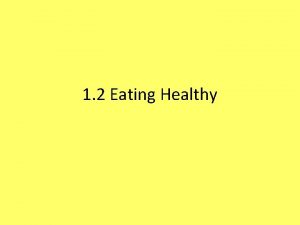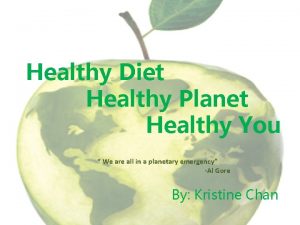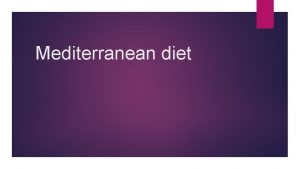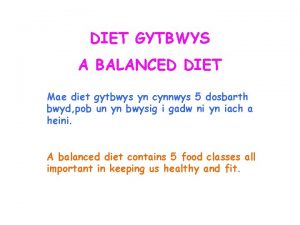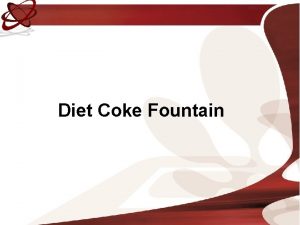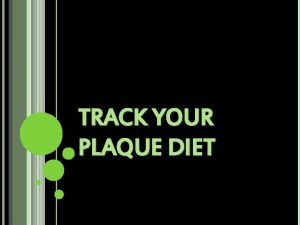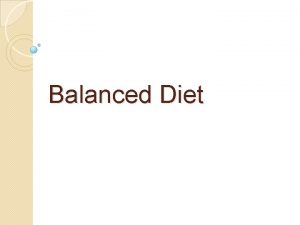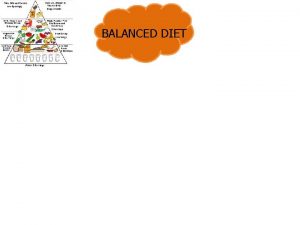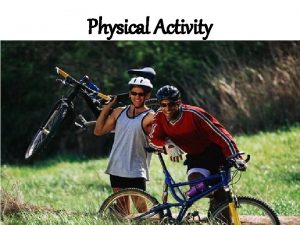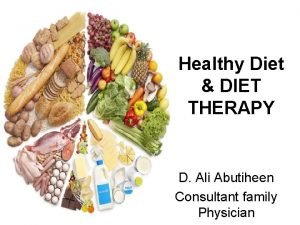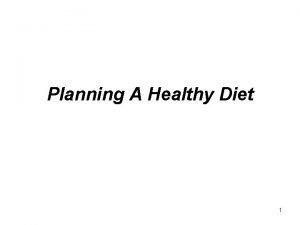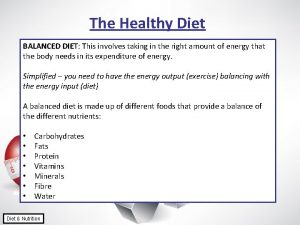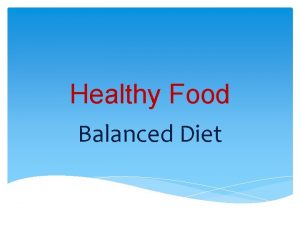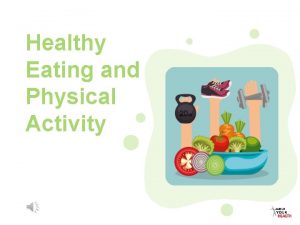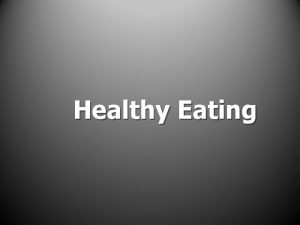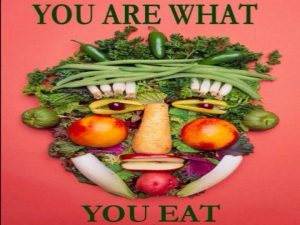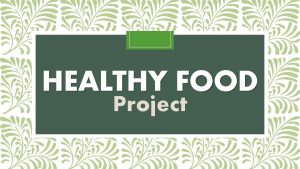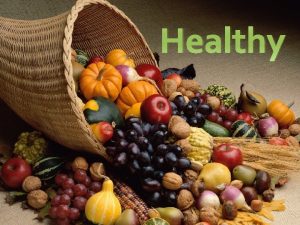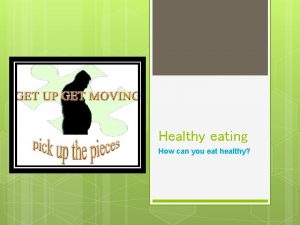The Importance of Healthy Diet Physical Activity in























- Slides: 23

The Importance of Healthy Diet & Physical Activity in Health and Wellbeing Theresa Lowry-Lehnen Nurse Practitioner Institute of Technology Carlow

Nutrition Each day, we make food choices that either benefit or harm our bodies Poor food choices contribute to the development of illnesses whereas healthy choices bring benefits Good nutrition plays a key role in preventing and treating illnesses such as diabetes, heart disease, obesity, high blood pressure, and osteoporosis. While other key factors influence health such as heredity, environment, lifestyle and mental attitude, nutrition is one thing people usually have quite a bit of control over

The Food Pyramid

The Food Pyramid The food pyramid represents how different foods and drinks contribute to a healthy balanced diet It organises foods and drinks into main categories, and explains daily quantities and allowances for a healthy diet Key messages: Limit high fat, sugar and salts Eat more fruit and vegetables (5 -7 servings per day) Portion sizes matter

Fats To help look after your heart it is important to make sure you choose the right type of fats Replace saturated fats with small amounts of mono and polyunsaturated fats Cut down on foods containing trans fats Saturated and trans fat are unhealthy fats These fats are most often solid at room temperature. Foods like butter, palm and coconut oils, cheese, and red meat have high amounts of saturated fat. It's also important to remember that all fats and oils are high in calories, so even the unsaturated fats should only be used in small amounts

Salt / Alcohol Salt Eating too much salt can increase the risk of developing high blood pressure High blood pressure increases the risk of developing coronary heart disease, kidney disease and stroke Alcohol If you drink alcohol, its important to keep within the recommended guidelines Remember alcohol contains calories

Sources of Calories in the Diet Carbohydrate 4 calories/gram Protein 4 calories/gram Fat 9 calories/gram Alcohol 7 calories/gram

Importance of Physical Activity Boosts energy Helps to control weight and tone muscle Combats illness Promotes better sleep Fun / enjoyment Better self-image Longevity Release endorphins and other feel-good chemicals to stabilise or improve mood Promotes psychological wellbeing Can reduce feelings of depression or anxiety New brain cell development & improved cognition and memory

Benefits of Physical Activity Physical Benefits Psychological Benefits Social Benefits Environmental Benefits Economic Benefits

Physical and Psychological Effects of Inactivity Heart Disease and Stroke High Blood Pressure Type 2 Diabetes Obesity Back Pain Osteoporosis Depression Anxiety Stress

Social Benefits of Physical Activity Confidence Positive self-image Improved self-esteem Physical activity can help develop important social skills especially participating in team sports or exercising with a group

Benefits of Physical Activity Environmental Benefits Economic Benefits Reduces traffic Reduced healthcare congestion Reduces pollution Air Noise Safer community costs Improved workplace productivity Reduction in absenteeism Lower transport costs

Obesity is a medical condition in which excess body fat may have an adverse effect on health, leading to reduced life expectancy and increased health problems

BMI Body mass index or BMI, identifies if an individual is a healthy weight for their height Weight in kilograms divided by height in metres squared = BMI Underweight: BMI is less than 18. 5 Normal weight: BMI is 18. 5 to 24. 9 Overweight: BMI is 25 to 29. 9 Obese: BMI is 30 -39. 9 Morbidly Obese: BMI over 40





What to do? Speak to the GP, or medical professional if overweight Importance of incorporating and maintaining a healthy well balanced diet and physical activity Activity: walking, cycling, swimming etc Start slowly and build up the level of activity Make a habit of it. Do the same activity at a moderate intensity for a set amount of minutes most days of the week When you get used to this, increase the time you spend doing the activity Then increase the intensity at which you do it Try out different activities for variety

How much exercise should I do a week? The recommended level for adults, starting at 19 years old At least 150 minutes (2 hours 30 minutes) of moderate-intensity exercise or 75 minutes (1 hour and 15 minutes) of vigorousintensity exercise each week. In addition, you should be doing muscle-strengthening exercises on two or more days that work all of the main muscle groups. 18 year olds are still growing and developing and therefore expected to do at least 60 minutes of physical activity a day. This should be a mixture of different moderate-intensity activities, including musclestrengthening activities on three days a week.

Get moving more every day Spend less time sitting and more time moving Start off slowly building at least 30 minutes of activity into the day Increase this gradually to 60 -90 minutes over time Break it down into short bursts – 10 -15 -minute bursts of moderate activity throughout the day can be easier to fit in to the day than doing it all in one go

Aerobic exercise The important thing is to get up and move about more during the day. Most of the activity should be aerobic and moderate in intensity This means that you are using your heart, lungs and larger muscles more effectively Breathing will deepen and the heart will pump slightly faster during aerobic exercise

Moderate Activity Brisk walking; a mile in 15– 20 minutes Medium paced swimming Water aerobics Cycling slower than 10 miles per hour Tennis (Doubles) Ballroom dancing General gardening Vigorous Activity Jogging or running a mile in 10 minutes or faster Active sports such as football or soccer, aerobics Circuit training Fast cycling (10 miles per hour or faster) or brisk rowing Swimming lengths Tennis Dancing such as quick step, hip hop, street, salsa Skipping Heavy gardening (continuous digging or hoeing) Hill-walking with a backpack
 Global strategy on diet physical activity and health
Global strategy on diet physical activity and health Mediterranean diet vs dash diet
Mediterranean diet vs dash diet Chapter 2 planning a healthy diet
Chapter 2 planning a healthy diet Fruitarian diet weight loss
Fruitarian diet weight loss Nutrition and productivity
Nutrition and productivity Healthy soil healthy life poster ideas
Healthy soil healthy life poster ideas Healthy community poster
Healthy community poster Healthy nurse healthy nation
Healthy nurse healthy nation Physical activity and physical fitness assessments grade 9
Physical activity and physical fitness assessments grade 9 Hình ảnh bộ gõ cơ thể búng tay
Hình ảnh bộ gõ cơ thể búng tay Frameset trong html5
Frameset trong html5 Bổ thể
Bổ thể Tỉ lệ cơ thể trẻ em
Tỉ lệ cơ thể trẻ em Chó sói
Chó sói Chụp phim tư thế worms-breton
Chụp phim tư thế worms-breton Chúa yêu trần thế alleluia
Chúa yêu trần thế alleluia Môn thể thao bắt đầu bằng chữ đua
Môn thể thao bắt đầu bằng chữ đua Thế nào là hệ số cao nhất
Thế nào là hệ số cao nhất Các châu lục và đại dương trên thế giới
Các châu lục và đại dương trên thế giới Công thức tiính động năng
Công thức tiính động năng Trời xanh đây là của chúng ta thể thơ
Trời xanh đây là của chúng ta thể thơ Mật thư tọa độ 5x5
Mật thư tọa độ 5x5 101012 bằng
101012 bằng độ dài liên kết
độ dài liên kết
